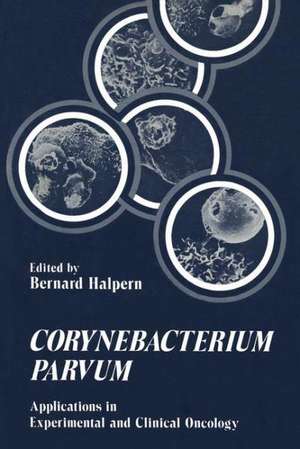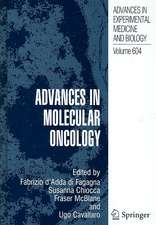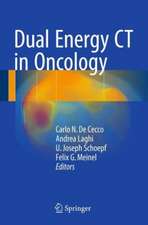Corynebacterium Parvum: Applications in Experimental and Clinical Oncology
Editat de Bernard Halpernen Limba Engleză Paperback – 12 oct 2011
Preț: 655.73 lei
Preț vechi: 690.24 lei
-5% Nou
Puncte Express: 984
Preț estimativ în valută:
125.51€ • 136.38$ • 105.50£
125.51€ • 136.38$ • 105.50£
Carte tipărită la comandă
Livrare economică 21 aprilie-05 mai
Preluare comenzi: 021 569.72.76
Specificații
ISBN-13: 9781461344308
ISBN-10: 1461344301
Pagini: 464
Ilustrații: XIV, 444 p.
Dimensiuni: 155 x 235 x 24 mm
Greutate: 0.65 kg
Ediția:Softcover reprint of the original 1st ed. 1975
Editura: Springer Us
Colecția Springer
Locul publicării:New York, NY, United States
ISBN-10: 1461344301
Pagini: 464
Ilustrații: XIV, 444 p.
Dimensiuni: 155 x 235 x 24 mm
Greutate: 0.65 kg
Ediția:Softcover reprint of the original 1st ed. 1975
Editura: Springer Us
Colecția Springer
Locul publicării:New York, NY, United States
Public țintă
ResearchCuprins
I: Bacteriology and Taxonomy.- 1. Bacteriological Aspect of Anaerobic Corynebacteria in Relation to RES Stimulation.- 2. Acute and Chronic Toxicities in Mammal and Subhuman Primates with Inactivated Corynebacterium Suspension.- Discussion.- II: Toxicology, Pharmacology, Adjuvant Properties.- 3. The Nature of the Active Principle of Corynebacterium parvum.- 4. Study on Soluble Substances Extracted from Corynebacterium parvum.- 5. Results Obtained in Our Adjuvant Screening Model with Corynebacterium parvum and Corynebacterium granulosum.- 6. Analysis of the Corynebacterium parvum Adjuvant Effects at the Cellular and Subcellular Levels.- Discussion.- III: Corynebacterium parvum in Microbial Immunity.- 7. Stimulating Effect of Corynebacterium parvum and C. parvum Extract on the Macrophage Activities against Salmonella typhimurium and Listeria monocytogenes.- 8. Antiviral Properties of Corynebacterium parvum.- 9. The Effects of Corynebacterium parvum Suspension on the Response to Tetanus Toxoid.- Discussion.- IV: Action of Corynebacterium parvum on the Immune Cell System.- 10. In Vivo Effects of Lymphocytes Sensitized in Vitro against Tumor Cells.- 11. The Action of Local Injections of Corynebacterium parvum in Facilitating the Extravasation of Activated Lymphoid Cells.- 12. Kinetics of Proliferation of Bone-Marrow Cell Lines after Injections of Immunostimulant Bacteria.- Discussion.- 13. Inhibition of Thymidine Incorporation of Tumoral YC8 Cells Cultured in Vitro by Peritoneal Macrophages Activated with Corynebacterium parvum.- 14. A Comparative, Scanning Electron Microscope Study of the Interaction between Stimulated or Unstimulated Mouse Peritoneal Macrophages and Tumor Cells.- Discussion.- 15. The Macrophage-Stimulating Properties of a Variety of Anaerobic Coryneforms.-16. Macrophage-Stimulating Effects of Anaerobic Coryneform Bacteria in Vitro.- Discussion.- 17. Comparative Studies on the Effect of Corynebacterium parvum on Bone-Marrow Cell Colony Formation in Vitro.- 18. Nonspecific Cytotoxic Activity of Peritoneal Exudate Cells against Isogenic Tumoral Cells in Animals Treated with Corynebacterium parvum.- Discussion.- V: Corynebacterium parvum in Experimental Tumors and Metastasis.- 19. An Analysis of the Increase in Host Resistance to Isogenic Tumor Invasion in Mice by Treatment with Corynebacterium parvum.- Discussion.- 20. Effect of Inactivated Corynebacterium on Different Experimental Tumors in Mice.- 21. Results of Investigations with Corynebacterium parvum in an Experimental Animal System.- 22. Tumor-Specific Rejection Associated with Killed Corynebacterium parvum.- 23. An Analysis of the Antitumor Effects of Corynebacterium parvum.- Discussion.- 24. Inhibition by Corynebacterium parvum of Lung-Nodule Formation by Intravenously Injected Fibrosarcoma Cells.- 25. Regression of Hamster Melanoma by Corynebacterium parvum.- 26. Corynebacterium granulosum -Induced Prophylaxis and Therapy of Artificial Pulmonary Metastases of Syngenic Murine Tumors.- Discussion.- 27. A Possibility of Synergism between Corynebacterium parvum and Lentinan, Serotonin, or Thyroid Hormone in Potentiation of Host Resistance against Cancer.- 28. Comparative Effects of Various Strains of Corynebacterium parvum and Other Prophylactic Agents on Tumor Development in Animals.- Discussion.- VI: Corynebacterium parvum in Human Tumors.- 29. A Chemotherapeutic Perspective on Clinical Trials with Corynebacterium parvum.- 30. Action of Corynebacterium parvum on the Phagocytic Activity of the Reticuloendothelial System in Cancer Patients (Preliminary Results).- 31. Corynebacterium parvum: Preliminary Report of a Phase I Clinical and Immunological Study in Cancer Patients.- Discussion.- 32. Results Obtained with Active Immunotherapy using Corynebacteria (Corynebacterium parvum or Corynebacterium granulosum) in the Treatment of Acute Lymphoid Leukemia.- 33. Therapeutic Trial with Reticulostimulin in Patients with Ear, Nose, or Throat Cancers.- 34. The Effect of Intravenous and Intramuscular Injection of Corynebacterium parvum.- 35. Report on 414 Cases of Human Tumors Treated with Corynebacteria.- Discussion.- VII: Concluding Remarks.- 36. Corynebacterium parvum: Outlook and Future.- 37. Closing Remarks.- Contributors.- Discussants.










